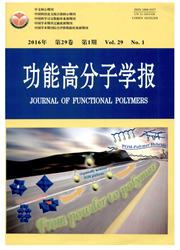

 中文摘要:
中文摘要:
采用静电纺丝方法制备了不同含量的偏氟乙烯和三氟乙烯的共聚物(P(VDF—TrFE))纳米纤维薄膜。通过P(VDF—TrFE)纳米纤维薄膜和柔性电极的结合,设计制作了一种针对医疗和服饰等领域应用的新型柔性压力传感器。利用扫描电镜和X射线衍射分析的方法分别对P(VDF—TrFE)纳米纤维的形貌和晶体结构进行了表征,并通过自制的测试系统获得了柔性压力传感器的灵敏度。结果表明:静电纺丝得到的纳米纤维具有较高的结晶度和β相结晶含量,其中P(VDF—TrFE)(n(VDF)/n(TrFE)=77/23)纳米纤维的口相结晶含量达到了51.3%,同时这种纳米纤维薄膜具有柔软、透气和生物相容性好等优点;基于电纺纳米纤维的柔性压力传感器具有良好的响应性能。P(VDF—TrFE)(T/(VDF)/n(TrFE)=77/23)压力传感器具有最高为60.5mV/N的灵敏度,接近于其塑性薄膜传感器,但塑性薄膜传感器的柔软性和透气性较差
 英文摘要:
英文摘要:
Nanofiber fabrics of P(VDF-TrFE) with varied VDF content were prepared by electrospinning. A new flexible force sensor was fabricated based on nanofiber fabrics and flexible electrode, which would be used in medical treatments and clothing. The morphology and crystal structure of the nanofiber fabrics were characterized by scanning electron microscopy and X-ray diffractometer. Flexible force sensors were tested with a self-made setup. Characterization results of nanofibers show that electrospun nanofibers have higher crystalline and β phase content, with the content of p phase in P(VDF-TrFE)(n(VDF)/n(TrFE)= 77/23) nanofibers reaching 51.3%. Furthermore, the nanofiber fabrics have some advantages such as good flexibility, air permeability and biocompatibility. Sensor testing results show that flexible force sensors have good response to external force. The highest sensitivity of 60.5 mV/N is found with the sensor based on P(VDF-TrFE)(n(VDF)/n(TrFE)=77/23) fabrics, which is close to the sensitivity of its plastic film sensor, but the plastic film sensor does not contain good flexibility and permeability, unlike the fabrics sensor.
 同期刊论文项目
同期刊论文项目
 同项目期刊论文
同项目期刊论文
 Characteristics of Several Kinds of Polyethylene Gel Estimated by Small-Angle Light Scattering Under
Characteristics of Several Kinds of Polyethylene Gel Estimated by Small-Angle Light Scattering Under Structural characterization and electrical and optical properties of V2O5 films prepared via ultraso
Structural characterization and electrical and optical properties of V2O5 films prepared via ultraso Synthesis of a Novel Triphenylamine Derivative and Exploration of Self-powered Electrochromic Device
Synthesis of a Novel Triphenylamine Derivative and Exploration of Self-powered Electrochromic Device Electrochromic kinetics of nanostructured poly(3,4-(2,2-dimethylpropylenedioxy)thiophene) film on pl
Electrochromic kinetics of nanostructured poly(3,4-(2,2-dimethylpropylenedioxy)thiophene) film on pl Dielectric studies on the heterogeneity and interfacial property of composites made of polyacene qui
Dielectric studies on the heterogeneity and interfacial property of composites made of polyacene qui 期刊信息
期刊信息
